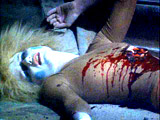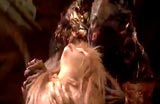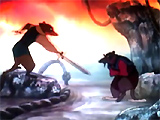
|
Deaths Scenes 1982 |


|
Director Ridley Scott's follow-up to his hit Alien (1979), one of the most popular and influential science-fiction films of all time, was set in a futuristic and dystopic Los Angeles of 2019. Its central character was weary, former police officer/bounty hunter Rick Deckard (Harrison Ford) who was reluctantly dispatched by the state to search for four android replicants (robotic NEXUS models) that had been created with limited life spans. The genetically-engineered renegades had escaped from enslaving conditions on an Off-World outer planet. Clear plastic raincoat-wearing replicant Zhora (Joanna Cassidy), an exotic dancer, crashed through plate glass windows before her shard-covered death, after she was repeatedly shot by replicant blade-runner Deckard. Replicant Pris (Darryl Hannah), an acrobat, died an agonizing death, screeching as her limbs flailed spastically, before Deckard shot her again in the stomach to end her misery. And Dr. Eldon Tyrell (Joe Turkel), the founder of the corporation that manufactured the NEXUS-6 models, experienced an eye-gouging death at the hands of replicant Roy Batty (Rutger Hauer). |
 Zhora  Pris  Dr. Tyrell |
||||||

|
Blade
Runner (1982) Android Roy Batty (Rutger Hauer) spared replicant-killer Rick Deckard's (Harrison Ford) life in a supreme act of choice and redemption. Still with the dove in his hand, Roy sat down in front of the dazed Deckard and delivered a climactic, majestic soliloquy from the depths of his heart with the rain streaming down his face - washing it [a baptismal symbol of cleansing, absolution and rebirth]. At the very moment of his own termination on the rain-drenched rooftop, he acquired the human capacities of caring and benevolence. His swan song was truly moving as he eloquently spoke about his own memories of the distant outposts in space that would be lost forever when he died. His android memories, as a top-of-the-line combat model, spoke of violent and aggressive attacks (attack ships, C-beams) that he presumably witnessed:
And then with a half-smile (before saying "Time to die") on his face [possibly the only sincere smile in the entire film] at the moment of his death, his head slumped down, and the white dove of peace [a symbol of Christianity's Holy Spirit, love, hope, etc.] was released. Its flight, symbolic of Roy's death and Deckard's rebirth, was captured in slow motion as it flew upward toward a blue sky, with a swelling of the Vangelis score. In voice-over, Deckard achieved empathy about the replicant's love of life as he mused:
|
 Roy Batty's Soliloquy  Head Slumping Down  Deckard Listening |
||||||

|
Creepshow (1982) Creepshow was a multi-story (five) anthology, directed by zombie horror master George A. Romero, with a script by another horror master, novelist Stephen King. In one of the film's five stories (The Lonesome Death of Jody Verrill), infected country moron Jordy Verrill (author Stephen King) committed suicide after discovering a radioactive meteor that turned everything into vegetation. Mournfully, he blew his head off to curtail his alien transformation into a green seaweed-draped zombie - as he prayed:
In another story in the anthology, They're Creeping Up on You, racist eccentric millionaire Upson Pratt (E. G. Marshall) died (off-screen) in his sterile penthouse swarmed by cockroaches. There was the creepy, sickening sight of cockroaches emerging from within his corpse. |
   Cockroach-Infested Body |
||||||

|
The Dark Crystal (1982) In this Jim Henson puppet fantasy film, there was a climactic death scene. Young humanoid-female, golden-haired, elf-like gelfling Kira (Kathryn Mullen, voice of Lisa Maxwell) was at the end of a quest to find the shard of the magical Crystal. She grabbed the Crystal shard when it fell from Jen's (Jim Henson, voice of Stephen Carlick) hands, but was surrounded by a evil group of bird-lizard hybrid creatures called Skeksis, Masters of the Dark Crystal who wore garish, raggy robes. When she carefully threw the shard back up to Jen, the High Priest Ritual Master (Jim Henson, voice of Jerry Nelson) stabbed her in the back from behind. Jen held the shard up over the Dark Crystal, a magical purple crystal in the decaying castle, as the light from the three suns beamed down onto the crystal. He plunged the shard into the Dark Crystal, after which he was thrown to the ground by a resonating blast from the crystal.
The urSkek were transformed into beams of light and energy which flowed through the Crystal and out into another world - now a lush landscape paradise. |
    
|
||||||

|
E.T.: The Extra-Terrestrial (1982) The stranded, odd-looking alien E.T. (voice of Pat Welsh) suffered death in an overwrought scene, witnessed by a heart-broken 10-year old friend Elliott (Henry Thomas) next to him. Both Elliott and E.T. were stretched out on long tables alongside each other within a quarantined and plastic-enclosed room in his house. The two were connected to life-support equipment that registered similar graphing results. Elliott protested: "You have no right to do this. You're scaring him. You're scaring him! Leave him alone. Leave him alone, I can take care of him." As E.T. began to approach death, his blood pressure sank, while Elliott's condition stabilized. Elliott held out his hand to E.T., tearfully asking him to stay connected: "E.T. Stay with me. Please...Together. I'll be right here. I'll be right here." E.T.'s life faded away. Elliott lost his telepathic connection to E.T. as he miraculously came back to full life: "The boy's coming back. We're losing E.T." The boy stretched his arms out to his dead friend, pleading for him to answer. A distraught Elliott screamed to E.T. as doctors and scientists rushed en masse to E.T.'s bedside and tore open the plastic coverings around him. Realizing that E.T. had no blood pressure, pulse or respiration, they made frantic efforts to revive the alien, administer CPR and other life supports - as Elliott reached out:
Tearful and sorrowful, Elliott kept a vigil next to E.T. and spoke lovingly to his dead, extra-terrestrial friend: "Look at what they've done to you. I'm so sorry. You must be dead, 'cause I don't know how to feel. I can't feel anything anymore. You've gone someplace else now. I'll believe in you all my life, every day. E.T. I love you." |
    
|
||||||

|
The Plague Dogs (1982) Martin Rosen's animated adventure drama was about two dogs involved in experimental research at the Lawson Park research facility, and who possibly were infected with the Bubonic Plague. Both dogs had countless memory or mental issues due to the countless times they had faced animal cruelty, endurance tests or had nearly been killed.
When they had the opportunity, the two escaped from their cages into the wild moors of Britain's Lake District, chased by 'whitecoats'. There was a very-unexpected shooting death of an uncharacteristically friendly hunter. When calling Snitter to come closer, the dog accidentally set off the man's hunting gun trigger and blew a shot-gun blast into his face. It was implied that they would devour the man's body (off-screen), and leave it mangled. This caused the community to begin hunting down the 'plague' dogs. In the film's conclusion, the two dogs swam out to sea - choosing to die rather than be captured by soldiers who were on their trail. The film faded before they reached what they thought they were swimming towards - an island. |
  Snitter's Accidental Killing of Hunter  Swimming Away and Presumably Drowning |
||||||

|
The Secret of NIMH (1982) Animator Don Bluth's directorial debut film, a fantasy-adventure drama, was based upon the 1971 children's novel Mrs. Frisby and the Rats of NIMH, [the National Institute of Mental Health] by Robert C. O'Brien. In the film's major death scene, power-hungry Jennar (voice of Paul Shenar), the rat leader of a group of rodents (rats and mice) had narrowly escaped from the NIMH after being subjected to laboratory experiments. During a sword duel, Jennar was first stabbed in the stomach by the heroic Justin (voice of Peter Strauss), the Captain of the Guards. Jennar then toppled off a cliff when struck in the back by a dagger thrown by Jennar's mortally-wounded ex-henchman Sullivan (voice of Aldo Ray), whom Jennar had earlier slashed in the throat with his sword. Jennar fell to his death in mud below. Sullivan perished shortly after. |
 Jennar Stabbed in Abdomen by Justin  Sullivan Throwing Dagger into Jennar's Back  Jennar Dying  Jennar Toppling From Cliff to Death in Mud |
||||||

|
Star Trek II: The Wrath of Khan (1982) There was a dramatic death scene involving Captain Spock (Leonard Nimoy), who had just sacrificed his life (after being exposed to radiation) to save the doomed starship U.S.S. Enterprise from a deadly explosion. Before he went to his death, Spock transferred his katra -- his memories and experience -- to Dr. Leonard "Bones" McCoy (DeForest Kelley) with the word "Remember." In a hoarse voice, he reassured Admiral James T. Kirk (William Shatner):
Kirk placed his hand opposite Spock's hand as his friend slowly collapsed, slumped down and expired next to him. Kirk quietly said: "No" as Spock died.
At Spock's funeral, Kirk delivered a heartfelt eulogy for his friend: before Spock was ejected into orbit around a newly-birthed planet from the Genesis Effect explosion:
|
  Kirk's Eulogy for Spock  Spock's Casket Ejected Into Orbit Around New Planet |
||||||
(chronological by film title) Intro | 1915-1929 | 1930-1933 | 1934-1938 | 1939 | 1940-1942 | 1943-1945 | 1946-1947 | 1948-1949 1950-1952 | 1953-1955 | 1956-1957 | 1958-1959 1960-1961 | 1962-1963 | 1964-1966 | 1967-1968 | 1969-1970 1971 | 1972 | 1973 | 1974 | 1975 | 1976 | 1977-1978 | 1979 1980 | 1981 | 1982 | 1983 | 1984 | 1985 | 1986 | 1987 | 1987 | 1988 | 1989 1990 | 1991 | 1992 | 1993 | 1994 | 1994 | 1995 | 1995 | 1996 | 1997 | 1998 | 1998 | 1999 2000-2001 | 2002 | 2003 | 2004 | 2005 | 2006 | 2007 | 2008 | 2009 | 2010 | 2011 |